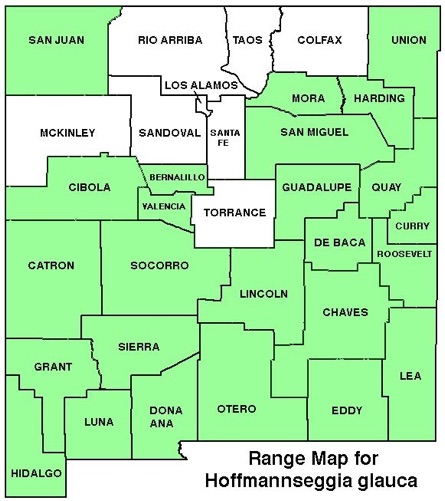WILDFLOWERS OF NEW MEXICO

Stems low growing from rhizomes with tubers. A slender, 6–12-inch tall flower stalk rises above a bed of feathery compound leaves. Clusters of 5–15 flowers bloom from the bottom up the spike. Note that red, stalked glands visible to the eye dot the stem and flowers. Also, no red glands dots are on the top or bottom surfaces of the leaflets.
FLOWER: March–September. The 1/2–1-inch wide (12–25 mm) flowers have slightly bilateral symmetry with 5 yellowish-orange, spatula-shaped petals with red markings and red glands on tiny stalks; stamens with showy red filaments and yellow anthers. The slightly curved pod is 1/2–1 1/2-inches long (12–38 mm), 3/16–5/16-inch wide (5–8 mm), also doted with red glands.
LEAVES: Alternate. Leaves twice compound with 5–11 pinnae along the midrib. Each pinnae is further divided into 4–11 pairs of 1/8–1/4-inch long (3–6 mm) leaflets. Reddish (turning black) glands cover the stem, flowers, and pods, but none are on the upper or bottom surfaces of the leaves.
HABITAT: Sandy, gravelly soils, plains, hills, open areas, roadsides, disturbed areas; prairies, desert grasslands and scrub.
ELEVATION: 3,700–6,000 feet.
RANGE: AZ, CA, CO, NM, OK, TX.
SIMILAR SPECIES: Two look-alikes in much the same range: Sicklepod Holdback, H. drepanocarpa, has yellow filaments and no red gland-dots anywhere; James Rush-Pea, Pomaria jamesii, has filaments with yellow bases and red tops, and leaflets with visible red gland-dots on the underside.
NM COUNTIES: Widespread statewide, except in mountains, in low- to mid-elevation, arid habitats: Bernalillo, Catron, Chaves, Cibola, Curry, De Baca, Dona Ana, Eddy, Grant, Guadalupe, Harding, Hidalgo, Lea, Lincoln, Luna, Mora, Otero, Quay, Roosevelt, San Juan, San Miguel, Sierra, Socorro, Union, Valencia.

INDIAN RUSH-PEA (HOG-POTATO)
HOFFMANNSEGGIA GLAUCA
Legume Family, Fabaceae
Perennial herb

THE CONTENTS OF THIS WEBSITE ARE COPYRIGHTED AND CANNOT BE USED
WITHOUT PERMISSION OF GEORGE OXFORD MILLER




Red, stalked glands cover the flower, stem, and seeds.

Twice-compound leaves; leaflets do not have red glandular dots on the underside.
Red, stalked glands cover the stems, flowers, buds, and seeds, but not the leaflets.
EMAIL ME